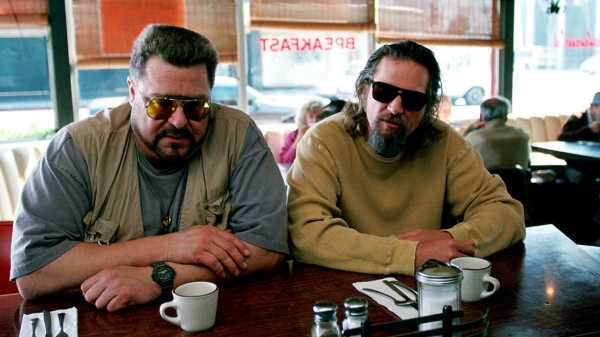
With “The Ballad of Buster Scruggs” adorning a handful of theatres as well as computers everywhere, thanks to its Netflix release, it’s a good week to recommend another Coen brothers film to stream, namely their best—“The Big Lebowski,” alas. “Alas” because it’s rather unoriginal to acknowledge the distinction of this movie, which, in 1998, was critically hemmed-and-hawed into mere respectability (and didn’t do well in theatres) but soon became a literal cult film that has spawned an academic industry and popular encyclopedics. The spectrum of adulation that has enfolded “The Big Lebowski” is apt for an idiosyncratic movie built with elements that had already become Coen trademarks—petty crime spinning out of control, caricatural characters, and splashily ear-catching dialogue—but also a movie that extends far beyond its immediate scope of activity to open extraordinary depths of political reflection.
“The Big Lebowski” is one of the great American political films, one that establishes its historical reach in a title card. Though made in 1997 (it premièred at Sundance in January, 1998), it’s a historical film set at the beginning of the nineteen-nineties, during the Gulf War, which is a frequent subject of discussion, no less than Saddam Hussein is himself a character in a fantasy sequence—and no less than the movie and its main characters are haunted by, damaged by, defined by, and trapped in the modern American history of war. The nominal title character (David Huddleston), who is linked to the Dude (Jeff Bridges) by an act of mistaken, um, carpet bombing, is a disabled veteran of the Korean War (and one who resembles Dick Cheney, who ran the Gulf War). The Dude’s best friend, the impulsively violent, punctilious, loyal-to-a-fault Walter Sobchak (John Goodman), is a Vietnam War veteran whose military experience informs and deforms his daily life.
The Dude himself, one of the great characters of the modern cinema, is an assemblage who’s as closely defined by his void zones as by his traits; his shambling-slacker manner, an apparent parody of the American sixties, turns out to be its apotheosis. A dropout, a stoner, a hedonist without even the energy to pursue much pleasure, Jeffrey Lebowski is a secretly great man, the truly big Lebowski, whose illustrious past, dropped into the story under postcoital questioning from the internationally celebrated artist Maude Lebowski (no relation) (played by Julianne Moore), is itself a sort of casualty of a war: he was a crucial New Left behind-the-scenes activist in the early sixties and a founder of another, more overtly confrontational New Left group in 1970.
The following two decades of the Dude’s life are a long comedown from times of activism, a sort of infinite hangover of political burnout that nonetheless suggests, in the penumbra of peaceful fantasy that surrounds him like a star cloud, the enduring principles of tolerance, openness, and freedom—the deeply structured ideals that survive and inform the Zen-like passivity of his benumbed routine. (It’s also a sharply vulnerable fidelity, one that easily comes under the sway of bullies parading their own set of belligerent principles.) Within the movie’s panorama of criminal plots—the Dude’s rug is wrongfully penalized, the grandee Lebowski’s young wife, Bunny (Tara Reid), is kidnapped—is a vision of false images and false heroes, of destructive men, failed men, dependent men, men salvaging an identity of sham grandeur, of performative masculinity that’s inseparable from the violence that they blunderingly inflict and endure.
“The Big Lebowski,” set in Los Angeles, is framed as a Western by the narration and the occasional presence of a deep-voiced wanderer (Sam Elliott) who seemingly migrates from the Wild West to the Far West like the tumbleweed montage with which the movie opens. In effect, it’s a movie of the Old West meeting the New West—of the ghost of the bloody gunfighter morphing into an avuncular and folksy spirit of personal, inner adventure. The stranger reminds viewers that, in the West, “dude” is an insult—the naïve and citified dandy who’s a mere tourist or poseur in a place of rugged action and broken-in casualness.
Yet Bridges’s Dude, the iconic slacker, wearing a bathrobe in public and (to all appearances) cavalierly indifferent to appearances, is an inventor of styles—far from the mere negation of style, he offers a new one, one that literally brings together the private and the public image, and one that, in its peculiar way, is closer to that of the authentic adventurer than to that of the purchaser of duds. Sixties style and sixties substance—the long throw of the New Left in political life, private life, and popular culture—converge, by way of gleefully idealistic imagination and mournful bitterness, in “The Big Lebowski.”
Movies that refract a wider world that’s dimly perceived in childhood and adolescence have a particular power, a particular place in many filmmakers’ œuvre, as does “The Big Lebowski” in the Coen brothers’ filmography. The Coens are children of the sixties in the literal sense (Joel was born in 1954; Ethan, in 1957); they weren’t in the front lines of the era’s turmoil but, rather, experienced it through media, through talk, doubtless through the experience of their parents and other elders. Their coming of age, in consciousness and conscience, spans the sixties, both chronologically and culturally, and “The Big Lebowski” offers the strange and resonant authority of filmmakers who, even as they gather anecdotes, incidents, and traits from the lives of others, seem to be looking deeply into their own formative concepts and references.
The soundtrack, adorned with music by the Rolling Stones, Creedence Clearwater Revival, and Bob Dylan, is a prime source of those references. Another source is the cinema itself, with the rise of modern cinephilia (at least, that of the Coens), thanks to old movies on TV, and in “The Big Lebowski” the Coens offer a crescendo of syncretic ingenuity in the creation of a Busby Berkeley-like musical fantasy sequence, fusing Berkeley’s high-style Freudian symbolism with the Dude’s slouchy personal repertory of desires and terrors, set to the newly anthemic pop-rock 1968 afterthought of the First Edition’s “Just Dropped In (To See What Condition My Condition Was In).” The Coens’ art of the chronological and cultural mashup is nothing less than a firsthand account à deux of life in an age of profuse media—and of the political history and rhetoric that it yields, preserves, and distorts. The time period of the Coens’ early history provides the spark for another film that, though not consistent, features some of their greatest inspirations, “A Serious Man,” and, above all, for the film that I consider second to “The Big Lebowski” in their body of work, “Inside Llewyn Davis,” in which the subject is Dylan, and, in particular, the transition from the Old Left to the New and from folk music to rock, the very concept of modern youth culture, the culture that prevails as the new mainstream to this day.
Stream “The Big Lebowski” on Amazon, Hulu, and other services.
Stream “A Serious Man” on Netflix, Amazon, and other services.
Stream “Inside Llewyn Davis” on Amazon, YouTube, and other services.
Sourse: newyorker.com






